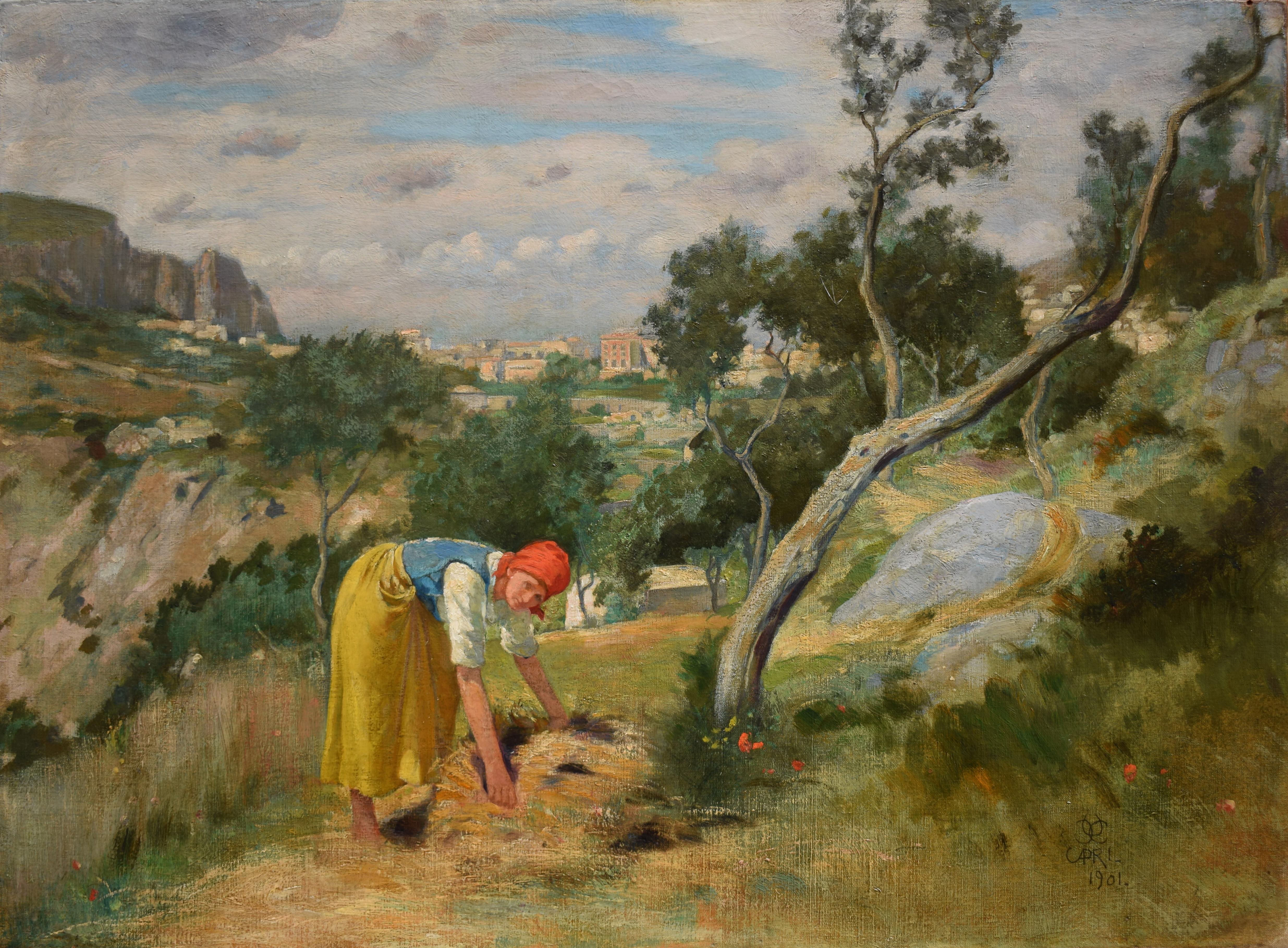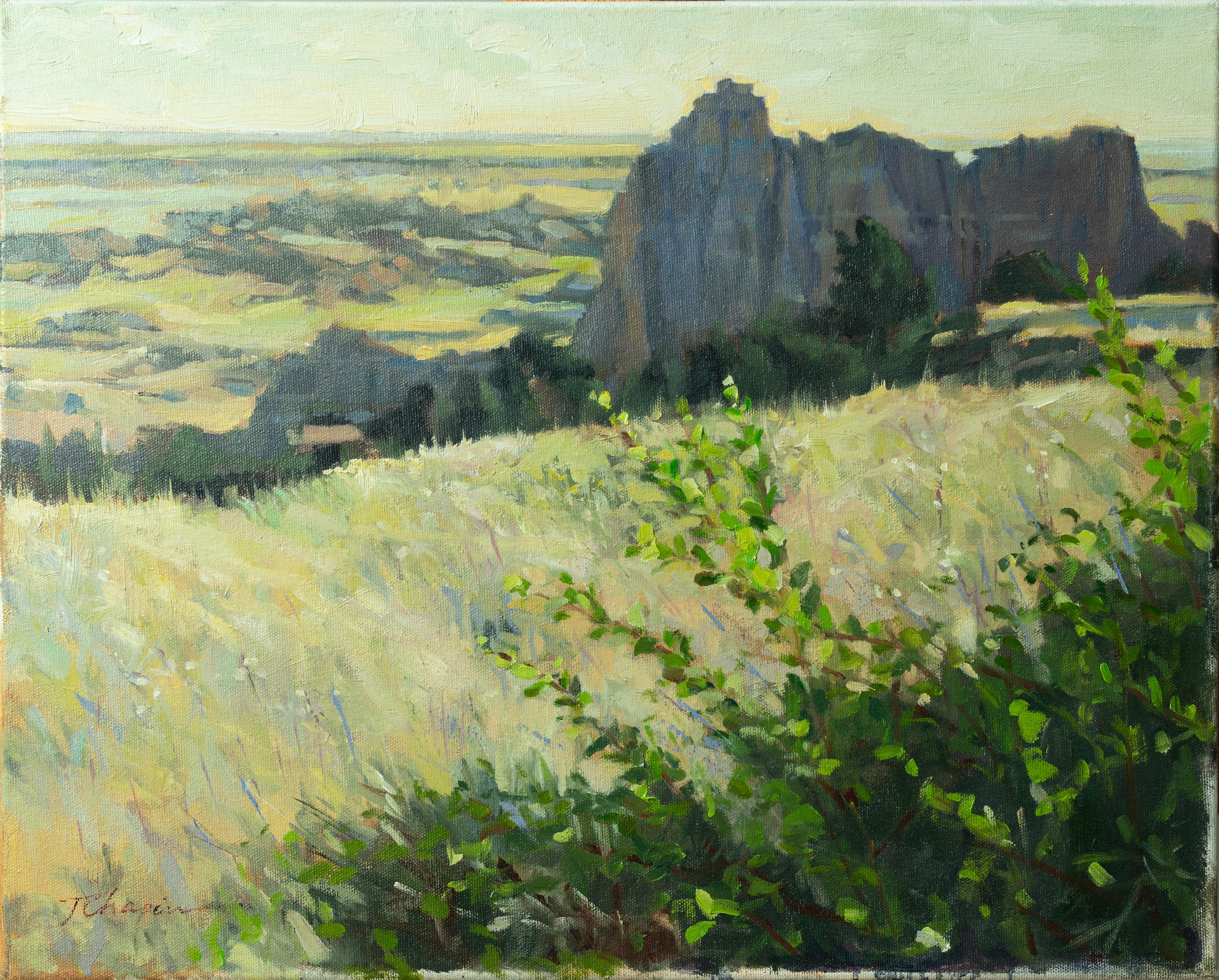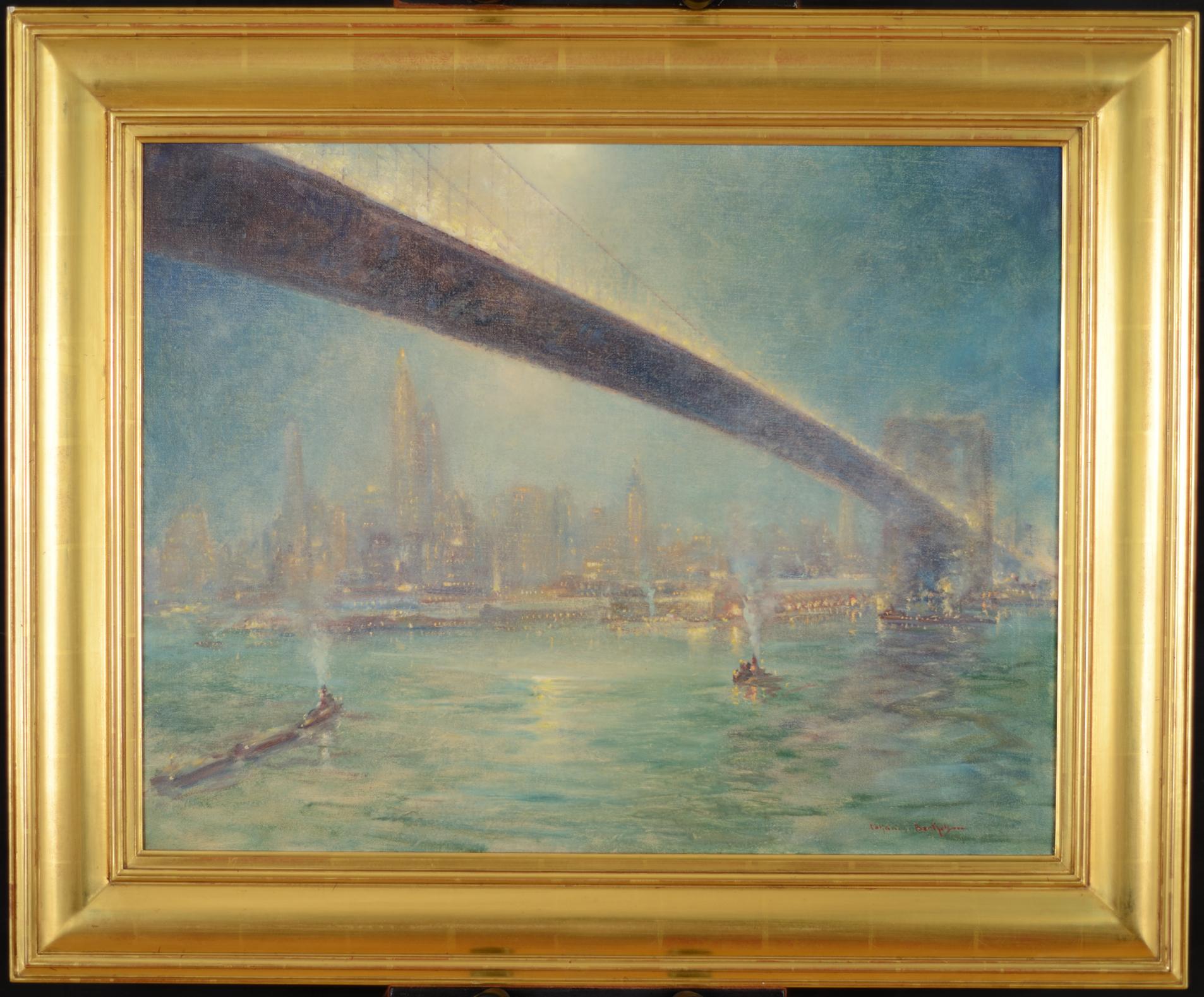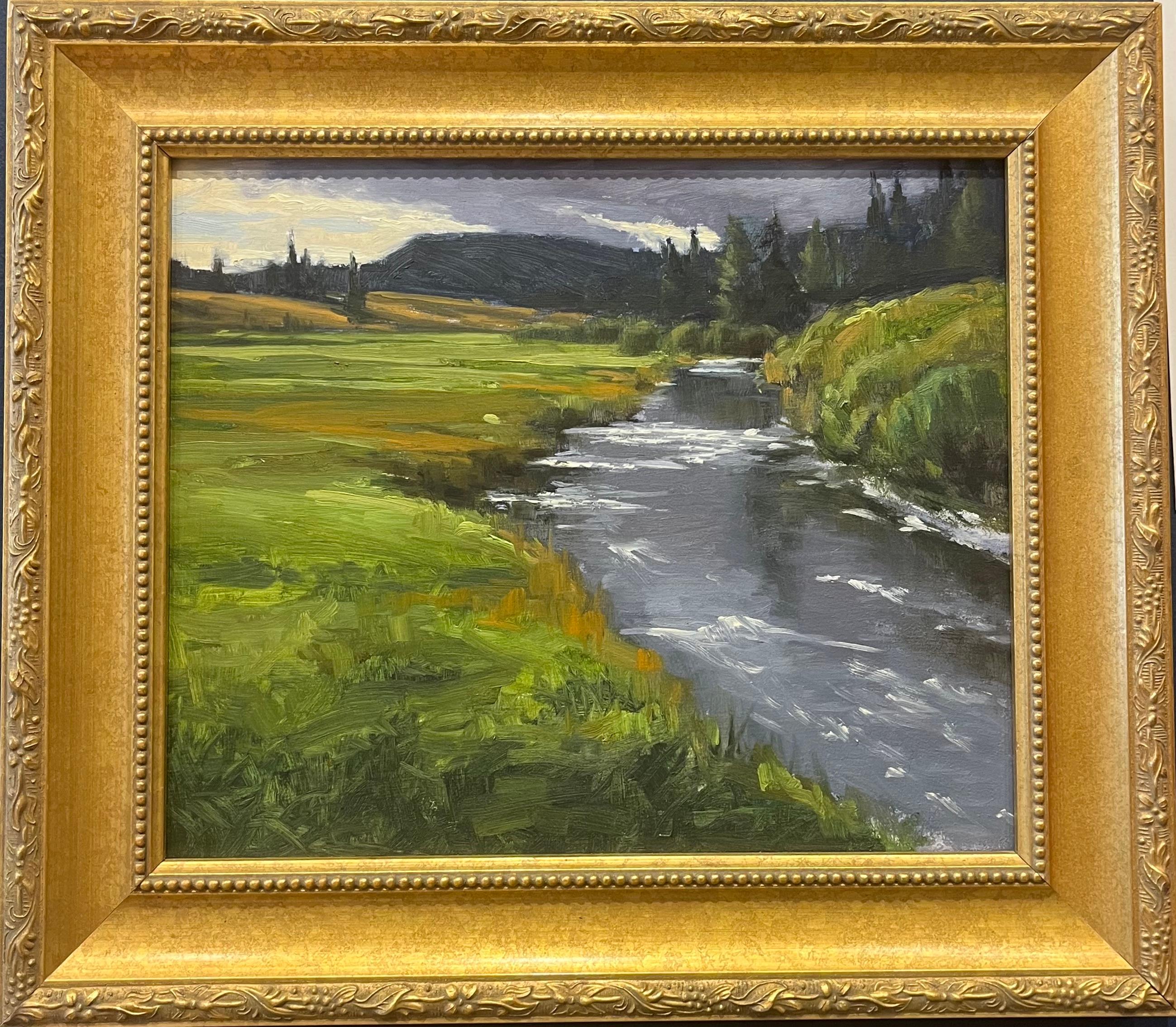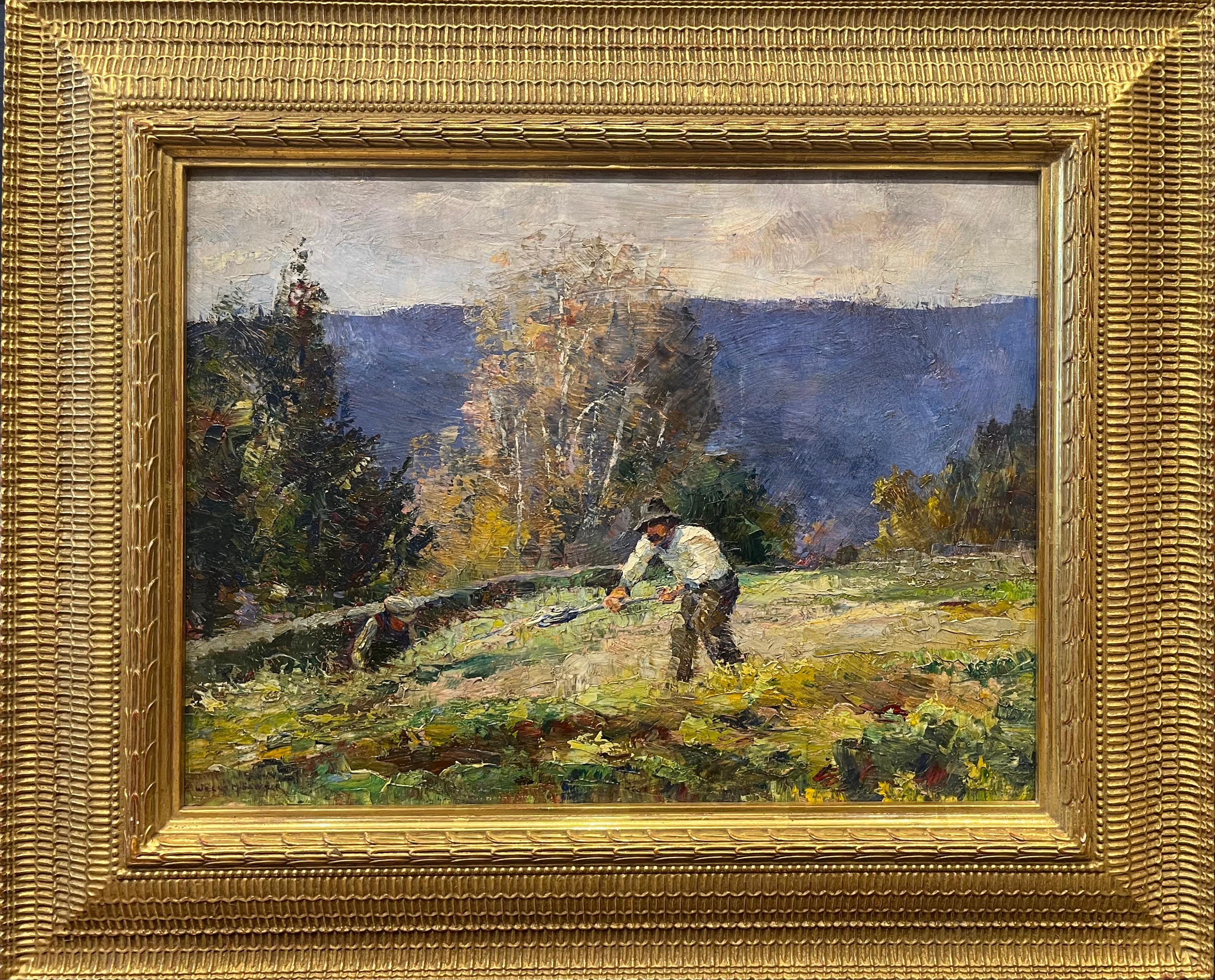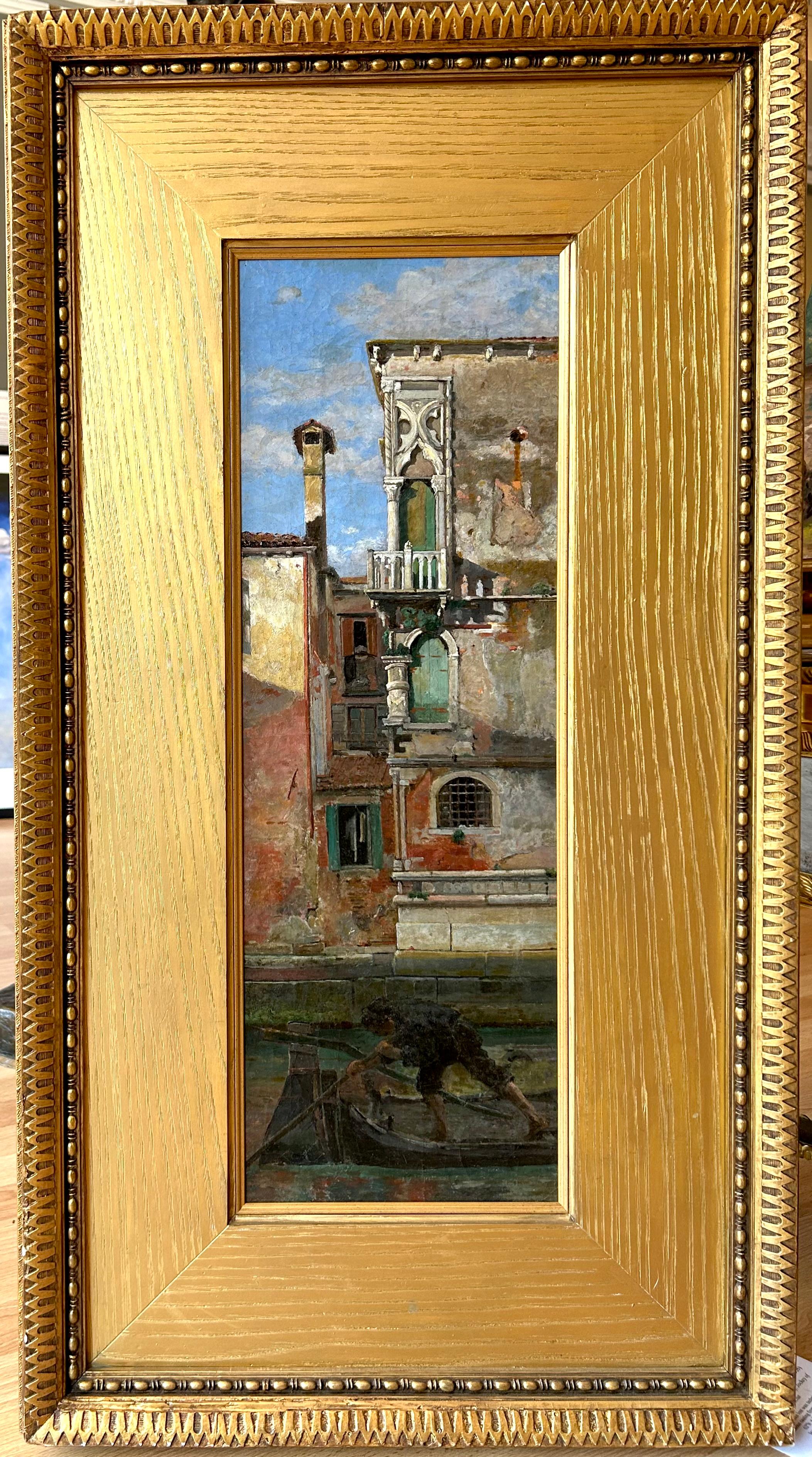Items Similar to "Wellfleet, Cape Cod, " Gerrit Beneker, American Impressionism, Provincetown
Want more images or videos?
Request additional images or videos from the seller
1 of 9
Gerrit Beneker"Wellfleet, Cape Cod, " Gerrit Beneker, American Impressionism, Provincetown1926
1926
About the Item
Gerrit Beneker (1882 - 1934)
Wellfleet, Cape Cod, Massachusetts, New England, 1926
Oil on canvas
20 x 16 inches
Signed, titled, and dated lower left
Provenance:
Louis H. Barnett, Fort Worth, Texas
In 1905, Gerrit Beneker began his art career as an illustrator. He married Flora Judd, his high school sweetheart from Grand Rapids and they moved to Brooklyn, NY. Gerrit's early passion was to create an art that would inspire and provide honor to the workingman. As such, he had no interest in painting portraits of pretty women, which were so often seen on the magazine covers of the day. Rather he wanted to seek out workingmen on the bridges, tunnels and skyscrapers of NYC, and paint them in their environments. He completed over 150 magazine covers, numerous ads including many for Ivory Soap and over 50 illustrations for magazine stories. Beneker was an idealist and an optimist. His early work reflects his connection to the hope and industrial energy of early 20th century America.
In 1912 Gerrit went to Provincetown to attend Charles Hawthorne's painting classes. Art works done during the next few years, demonstrate a skill in impressionist landscape techniques. Meanwhile, his studio works retained a traditional, representational style and he continued to do illustrations for the NYC art editors. Gerrit was a founding member of the Provincetown Art Association and was very active in the development of the art colony.
In 1918 Gerrit was asked to come to Washington DC to paint posters for the US Navy. The objective of the assignment and the posters was to foster support for the war effort among workingmen. His most famous poster, "Sure We'll Finish the Job", sold over 3 million copies.
The next year Hydraulic Pressed Steel Co., Cleveland, Ohio, hired Beneker as an artist in residence. His job was to paint the men in the factories and steel mills - to improve the relationship of labor and management. The assignment lasted four years. The family, now including four children, Katharine, Benson, Helen and Jean, returned to Provincetown for the summers. In 1920 they bought a summer home in Truro. They moved 21 times during Gerrit's career.
The "Industrial" paintings, as they were known, went on tour across the country for 12 years, until 1934 when Gerrit died, and they were stored in the summer home. In the early 1920's Gerrit became known as the foremost painter of American industry. Later he also painted on site at General Electric in Schenectady, NY. and at Rohm & Haas in Philadelphia.
Beneker was primarily a man of ideas, believing as Ralph Waldo Emerson did, that the highest purpose of art was to create character. It is not possible to separate the art from his beliefs, as they are one in the same. To promote his ideas and paintings, Gerrit traveled across the country, giving over 200 lectures. Speaking mostly on the role of art in our everyday lives, he would modify the topic to fit his audience, resulting in talks such as "Art in Business", "Art and Education", "Art as a Constructive Force" and so forth.
Beneker's works were published in 80 plus publications, including Scientific American, American Magazine of Art, Pearson's, The Mentor, Baseball and Ambition magazines. Art works included the opening of the Panama and Cape Cod canals, the building of the Manhattan bridge, the laying of the Atlantic cable, and over 30 Baseball covers.
Beneker's works were shown in over 250 exhibits, from the Midwest to the Northeast and Southern states. Nearly 90 magazine and newspaper articles mention his artwork, many focusing on his role as a champion of the workingman, and several written by Gerrit himself.
Beneker painted about 500 oil paintings over his nearly 30 year career, not including those done for magazine illustrations. His primary expertise lay in his portraits, which included not only the industrials but also many paintings of friends and family and several of Cape Cod fishermen. These represent about a third of his paintings. His landscapes and marine paintings together represent more than half of his painting and include a majority of harbors scenes. He also painted around several still life pictures and a few paintings of the mountains in New Hampshire and Vermont.
- Creator:
- Creation Year:1926
- Dimensions:Height: 25.5 in (64.77 cm)Width: 21.5 in (54.61 cm)
- Medium:
- Movement & Style:
- Period:
- Condition:Excellent.
- Gallery Location:New York, NY
- Reference Number:1stDibs: LU184129905752
About the Seller
5.0
Platinum Seller
These expertly vetted sellers are 1stDibs' most experienced sellers and are rated highest by our customers.
Established in 2021
1stDibs seller since 2022
60 sales on 1stDibs
Typical response time: 1 hour
- ShippingRetrieving quote...Ships From: New York, NY
- Return PolicyA return for this item may be initiated within 3 days of delivery.
More From This SellerView All
- "View of Boats in Gloucester Harbor, " Emile Gruppe, American ImpressionismBy Emile Albert GruppeLocated in New York, NYEmile Albert Gruppe (1896 - 1978) View of Boats in Gloucester Harbor, Cape Ann, Massachusetts circa 1925 Oil on canvas 25 x 30 inches Signed lower right Emile Gruppe was an unusually prolific artist. He was at his easel almost every day and created thousands of paintings over a career that lasted 60 years. At his peak, he was completing almost 200 oil paintings a year. Yet he has never failed to find an audience for his depictions of New England in autumn and winter, or his harbor scenes of Rockport and Gloucester in Massachusetts. Gruppe was born in 1896 in Rochester, New York to an artistic family--his father, brother, sister and nephew were all artists. Emile spent his youth in Katwyk an Zee, a fishing village in Holland, where his father, Charles Gruppe, worked as both an artist and an art dealer. Emile lived in the Netherlands until he was 17, when the family returned permanently to the United States to avoid World War I. In New York City, Gruppe attended classes at the National Academy of Design and at the Art Students League, where he studied under Charles Chapman and George Bridgman. He also studied with John Carlson in Woodstock, New York, where he gained an appreciation for outdoor painting. Carlson “turned me into a painter,” he later said. Gruppe helped found the Rockport Art Association in 1921, but he is most closely linked to Gloucester where he lived from about 1940 until his death. He operated the Gloucester School of Painting from the 1940s into the 1970s and helped turn the Rocky Neck area of East Gloucester into a world-famous art colony. The school boasted an impressive faculty but Gruppe’s own exuberant plein-air demonstrations were often the highlight of the week. Gloucester, with its fleet of whimsically painted fishing vessels, crowded wharf buildings and shacks, and picturesque inhabitants, never ceased to fascinate Gruppe. He also helped popularize Rockport’s famous fishing shack known as Motif #1, sometimes called “the most often-painted building in America.” By the 1940s, Gruppe was one of the most prominent of the Cape Ann artists...Category
1920s American Impressionist Landscape Paintings
MaterialsCanvas, Oil
- "Frosty Morning, " Jonas Lie, American Impressionist Winter Snow Landscape SceneBy Jonas LieLocated in New York, NYJonas Lie (1880 - 1940) Frosty Morning, Adirondacks, circa 1925 Oil on canvas 40 x 50 inches Signed lower left Provenance: Samuel and Ileen Campbell Wright ...Category
1920s American Impressionist Landscape Paintings
MaterialsCanvas, Oil
- "Sensation in Wall Street, New York" Herman Hyneman, Jewish Artist, Gilded AgeBy Herman HynemanLocated in New York, NYHerman N. Hyneman (1849 - 1907) Sensation in Wall Street, New York, 1903 Oil on canvas 24 x 16 inches Signed and dated lower left Provenance: Roger King, Newport, Rhode Island Herman N. Hyneman was a noted American portrait and figure painter with ties to both Philadelphia and New York. He was born July 27,1849 to Leon and Adeline Hyneman in Philadelphia. ("Who Was Who in American Art" lists his birth date as either 1849 or 1859, but we have confirmed that the birth date is 1849). Virtually nothing is known about his early years, but given the fact that the family resided in a wealthy section of Philadelphia and the fact that he traveled to Paris to study in the studio of Leon Bonnat when he was but 20 years old, it is presumed that the family was financially comfortable if not well to do. Hyneman exhibited at the Paris Salon in 1879 and 1881, which was quite an accomplishment given his tender age. He returned to the United States in 1882 and after a year in Philadelphia, he established a studio at 58 West 57th Street, New York, NY, where he painted portraits to support himself and scenes of beautiful fair-skinned women walking in the snow to exhibit at major exhibitions throughout the United States. Hyneman exhibited at the the Brooklyn Art Association in 1882, 1883 and 1884 and at the Pennsylvania Academy of Fine Arts in 1883 and 1888. Beginning in 1882 and continuing up until 1905, he exhibited regularly at the National Academy of Design. Despite the fact that he exhibited fourteen paintings at the National Academy over a span of three different decades, he was never elected as a member. In the 1880's his paintings sold for between $100 and $1500, which were substantial sums for that period. Hyneman also exhibited at the Salmagundi Club and the Philadelphia Art Club and was a member of each organization. He won a medal at the American Art Society in 1904 and also exhibited at the Chicago Art Institute. A handwritten label on one of his paintings indicates that he also exhibited in Budapest, Hungary. In 1892, Hyneman married the noted artist Juliet Jolley (aka Jolly), who had previously modeled for him. Thereafter, they shared a studio and on at least one occasion exhibited together. The February 5, 1896 edition of the "New York Times" reported on a "pleasant studio reception" at 58 West 57th Street where the paintings of both Herman and Juliet were shown to members of New York Society including Mr. And Mrs. Edwin Blashfield. At least one of Hyneman's Painting " A Sensation on Wall Street" which depicted a lovely young woman in fur coat with Muff in front of the Stock Exchange, was made into a post card and reproductions of his paintings are known to exist, although not plentiful. At least one etching is known, "Desdemona," which was reproduced in a book by Frederic Stokes. Herman Hyneman...Category
Early 1900s American Impressionist Landscape Paintings
MaterialsOil, Canvas
- "Elegant Lady in Winter, Trinity Church, New York" Herman Hyneman, Gilded AgeBy Herman HynemanLocated in New York, NYHerman N. Hyneman (1849 - 1907) Elegant Lady in Winter, Trinity Church, New York City Oil on canvas 22 x 15 inches Signed lower right Provenance: Freemans, 2005, Lot 76 Herman N. Hyneman was a noted American portrait and figure painter with ties to both Philadelphia and New York. He was born July 27,1849 to Leon and Adeline Hyneman in Philadelphia. ("Who Was Who in American Art" lists his birth date as either 1849 or 1859, but we have confirmed that the birth date is 1849). Virtually nothing is known about his early years, but given the fact that the family resided in a wealthy section of Philadelphia and the fact that he traveled to Paris to study in the studio of Leon Bonnat when he was but 20 years old, it is presumed that the family was financially comfortable if not well to do. Hyneman exhibited at the Paris Salon in 1879 and 1881, which was quite an accomplishment given his tender age. He returned to the United States in 1882 and after a year in Philadelphia, he established a studio at 58 West 57th Street, New York, NY, where he painted portraits to support himself and scenes of beautiful fair-skinned women walking in the snow to exhibit at major exhibitions throughout the United States. Hyneman exhibited at the the Brooklyn Art Association in 1882, 1883 and 1884 and at the Pennsylvania Academy of Fine Arts in 1883 and 1888. Beginning in 1882 and continuing up until 1905, he exhibited regularly at the National Academy of Design. Despite the fact that he exhibited fourteen paintings at the National Academy over a span of three different decades, he was never elected as a member. In the 1880's his paintings sold for between $100 and $1500, which were substantial sums for that period. Hyneman also exhibited at the Salmagundi Club and the Philadelphia Art Club and was a member of each organization. He won a medal at the American Art Society in 1904 and also exhibited at the Chicago Art Institute. A handwritten label on one of his paintings indicates that he also exhibited in Budapest, Hungary. In 1892, Hyneman married the noted artist Juliet Jolley (aka Jolly), who had previously modeled for him. Thereafter, they shared a studio and on at least one occasion exhibited together. The February 5, 1896 edition of the "New York Times" reported on a "pleasant studio reception" at 58 West 57th Street where the paintings of both Herman and Juliet were shown to members of New York Society including Mr. And Mrs. Edwin Blashfield. At least one of Hyneman's Painting " A Sensation on Wall Street" which depicted a lovely young woman in fur coat with Muff in front of the Stock Exchange, was made into a post card and reproductions of his paintings are known to exist, although not plentiful. At least one etching is known, "Desdemona," which was reproduced in a book by Frederic Stokes. Herman Hyneman...Category
Late 20th Century American Impressionist Landscape Paintings
MaterialsCanvas, Oil
- "The Green Parasol, " Henry Hannig, American Impressionist, Woman in Beach SceneBy Henry HannigLocated in New York, NYHenry Charles Hannig (1883 - 1948) The Green Parasol Oil on canvas mounted on board 6 x 7 3/4 inches Provenance: R.H. Love Galleries, Chicago, Illinois Private Collection, Lake Orion, Michigan Hannig, born in Hirschberg, Germany on 27 February 1883, came to America with his parents at the age of seven. He attended school in the southwest suburbs before the family settled in Chicago. Young Henry enrolled in the Chicago Academy of Fine Arts where Lawton Parker became his mentor. He made ends meet by working in industrial design and illustration. By 1908 he was a pupil in the School of the Art Institute of Chicago where students followed the traditional European drawing curriculum, beginning with the copying of master engravings and drawing after plaster casts, then concentrating on the nude figure. Students worked toward the goal of winning various academic prizes. One of Hannig's fellow students was Louis Ritman...Category
1910s American Impressionist Figurative Paintings
MaterialsCanvas, Oil, Board
- "Spanish Mission in Florida, " Anthony Thieme, Cape Ann ImpressionistBy Anthony ThiemeLocated in New York, NYAnthony Thieme (1888 - 1954) Spanish Mission, Florida Oil on canvas 25 x 30 inches Signed lower left; titled on the reverse Anthony Thieme was born in...Category
Early 20th Century American Impressionist Landscape Paintings
MaterialsCanvas, Oil
You May Also Like
- Peasant woman at work in the fields of CapriBy Charles Caryl ColemanLocated in Roma, RMCharles Caryl Coleman (Buffalo 1840 – Capri 1928), Peasant woman at work in the fields of Capri (1901) Oil painting on canvas 35 x 49 cm, signed, located and dated Capri 1901 lower ...Category
Early 1900s American Impressionist Landscape Paintings
MaterialsCanvas, Oil
- Badlands (South Dakota) - Plein Air Landscape painting green yellow colorsBy Jane ChapinLocated in Cody, WYThis is a 'Plein Air" landscape Painting by Jane Chapin as seen in the viewing room exhibition on Silas VON MORISSE GALLERY. “Plein-Air” is the French expression to describe the act...Category
2010s American Impressionist Landscape Paintings
MaterialsCanvas, Oil
- Bridge Nocturne oil painting by Johann BerthelsenBy Johann Berthelsen, 1883-1972Located in Hudson, NYOne of Johann Berthelsen's iconic nocturne views of New York City across the Hudson River. Bridge Nocturne (c.1945) Oil on canvas, 22" x 28" 29 ½" x 36" x 2" framed Signed "Johann ...Category
1940s American Impressionist Landscape Paintings
MaterialsCanvas, Oil
- Oil River and Mountain LandscapeLocated in Fredericksburg, VAThis oil on canvas landscape painting depicts a grassy river scene with mountains in the distance. The brushstrokes are very representative of the impressionist movement, but the col...Category
Late 20th Century American Impressionist Landscape Paintings
MaterialsCanvas, Oil
- Oil Landscape of Man Plowing Field Titled The Garden in AutumnLocated in Fredericksburg, VAThis painting depicts the world famous Untermeyer Garden in Yonkers, New York. Sawyer was an American painter, illustrator, and photographer. He took photographs and made paintings o...Category
Mid-20th Century American Impressionist Landscape Paintings
MaterialsCanvas, Oil
- Oil Landscape of Italy Corner of Piazzo Del CampoBy William GrahamLocated in Fredericksburg, VAThis wonderful oil on canvas landscape was done by the famed William Graham. William Graham was an American landscape painter who spent most of his life and career abroad. He was bor...Category
Late 19th Century American Impressionist Landscape Paintings
MaterialsCanvas, Oil
